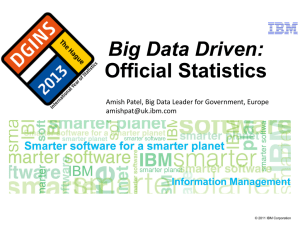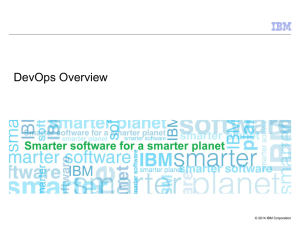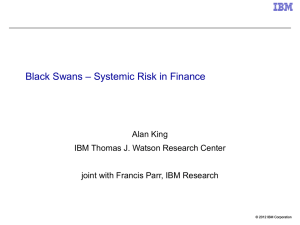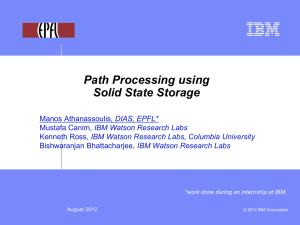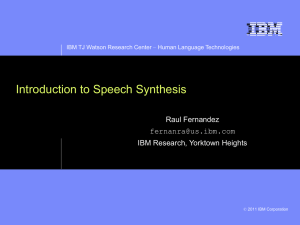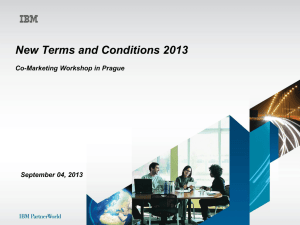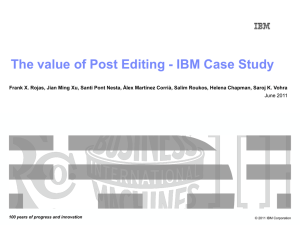Chapter 9: Using programming languages on z/OS
advertisement
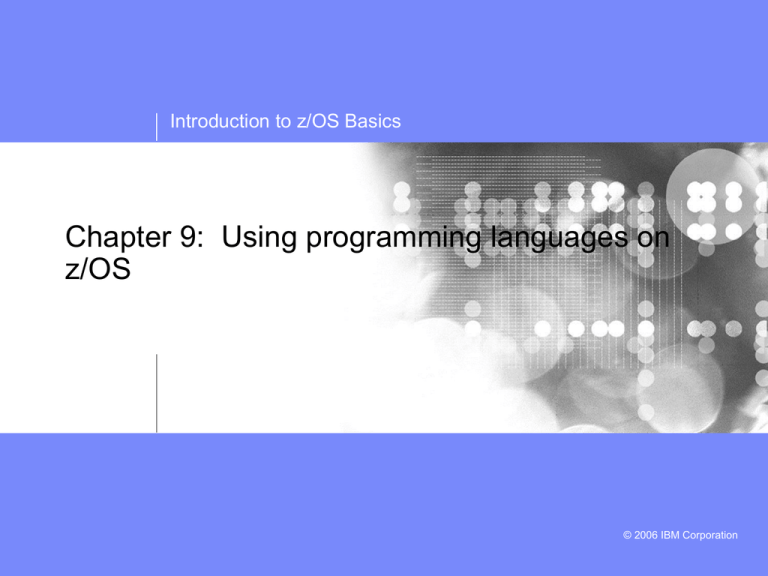
Introduction to z/OS Basics Chapter 9: Using programming languages on z/OS © 2006 IBM Corporation Chapter 09 Programming Languages Chapter objectives Be able to: List several common programming languages for the mainframe Explain the differences between a compiled language and an interpreted language 2 Create a simple CLIST or REXX program Choose an appropriate data file organization for an online application Compare the advantages of a high level language to those of Assembler language Explain the relationship between a data set name, a DD name, and the file name within a program Explain how the use of z/OS Language Environment affects the decisions made by the application designer © 2006 IBM Corporation Chapter 09 Programming Languages Key terms in this chapter assembler I/O (input/output) binder interpreter compiler load modules debugging pre-processor dynamic link library programming language generation variable 3 © 2006 IBM Corporation Chapter 09 Programming Languages Overview of programming languages A programming language is the way that a programmer instructs a computer to perform functions Computers only understand machine language Machine language is in binary form and, thus, very difficult to write Humans write programs in a programming language, which is converted into machine language for the computer to process There are many programming languages that have evolved from machine language 4 © 2006 IBM Corporation Chapter 09 Programming Languages Classification of programming languages 1st generation – Machine language – specific to hardware and software 2nd generation – Assembler language – Specific to hardware – Must be assembled – Symbolic machine instructions plus data structures corresponding to machine storage and registers 5 © 2006 IBM Corporation Chapter 09 Programming Languages Classification of programming languages (continued) 3rd generation – Procedural languages, known as high-level languages (HLL) – Example: COBOL – Must be translated (compiled) before execution – Usually portable (to an extent) across hardware and software platforms with a recompile 4th generation – 4GL – Non-procedural languages – Report generators – Query languages – Examples: • RPG, CSP, QMF, SQL 6 © 2006 IBM Corporation Chapter 09 Programming Languages Classification of programming languages (continued) Visual programming languages (or event-driven languages) – Visual Basic, Visual C++ Object-Oriented language – used in OO technology, e.g. Smalltalk, Java, C++ Other languages – 3D applications Scripting languages – Perl – REXX – HTML 7 © 2006 IBM Corporation Chapter 09 Programming Languages Choosing a programming language for z/OS Which language to use? Factors to consider include: Response time requirements for the application Budget allotted for development and ongoing support Time constraints of the project Whether subroutines will be coded in different languages Whether to use a compiled or an interpreted language 8 © 2006 IBM Corporation Chapter 09 Programming Languages Using Assembler language on z/OS Assembler language – Not usually used for application development – Machine-specific Used when: – Accessing bits or bytes – Accessing system control blocks – Execution efficiency is needed (performance) – Require high performance subroutines that can be called from HLL programs 9 © 2006 IBM Corporation Chapter 09 Programming Languages From Assembler source to executable module Assembler language source statements High Level Assembler Machine language version of the program Messages and listings Binder Executable load module 10 © 2006 IBM Corporation Chapter 09 Programming Languages Using COBOL on z/OS COBOL is an English-like programming language Used for business-oriented applications Capabilities of IBM Enterprise COBOL for z/OS and OS/390 – Integrate COBOL applications into Web-oriented business processes – Inter-operability with Java – Parsing of data in XML and Unicode formats 11 © 2006 IBM Corporation Chapter 09 Programming Languages From HLL source to executable module HLL Source statements HLL compiler Machine language version of the program Messages and listings Binder Executable Load module 12 © 2006 IBM Corporation Chapter 09 Programming Languages HLL relationship between JCL and program files //MYJOB JOB //STEP1 EXEC IGYWCLG INPUT-OUTPUT SECTION. FILE-CONTROL. SELECT INPUT ASSIGN TO INPUT1 ..... SELECT DISKOUT ASSIGN TO OUTPUT1 ... FILE SECTION. FD INPUT1 BLOCK CONTAINS... DATA RECORD IS RECORD-IN 01 INPUT-RECORD ... FD OUTPUT1 DATA RECORD IS RECOUT 01 OUTPUT-RECORD /* //GO.INPUT1 DD DSN=MY.INPUT,DISP=SHR //GO.OUTPUT1 DD DSN=MY.OUTPUT,DISP=OLD 13 © 2006 IBM Corporation Chapter 09 Programming Languages HLL relationship between JCL and program (continued) COBOL SELECT statement makes the link between the DDNAMEs INPUT1 and OUTPUT1 and the COBOL FDs INPUT1 and OUTPUT1 respectively The COBOL FDs are associated with group items INPUT-RECORD and OUTPUT-RECORD The program is completely independent of the location of the data or the name of the data sets. 14 © 2006 IBM Corporation Chapter 09 Programming Languages Relationship between JCL, program, and data set DSNAME DDNAME program OPEN FILE=INPUT1 READ FILE=INPUT1 ... CLOSE FILE=INPUT1 15 JCL for JOB //INPUT1 DD DSNAME=MY.INPUT MY.INPUT © 2006 IBM Corporation Chapter 09 Programming Languages Using PL/I on z/OS Full-function, general-purpose high-level programming language Suited for – System programming – Commercial – Engineering/scientific, etc. Less verbose than COBOL Less English-like 16 © 2006 IBM Corporation Chapter 09 Programming Languages HLL relationship between JCL and program files Referring to physical files by a symbolic file name is used by all of the HLLs - even Assembler language Isolates your program from changes to data set name and data set location – data set name and location can change without recompiling program “Hard-coding” data set names or other such information in a program is not usually considered a good programming practice – Externalize these values from programs 17 © 2006 IBM Corporation Chapter 09 Programming Languages HLL relationship between JCL and program files //MYJOB JOB //STEP1 EXEC CLG ... OPEN FILE=INPUT1 OPEN FILE=OUTPUT1 READ FILE=INPUT1 ... WRITE FILE=OUTPUT1 ... CLOSE FILE=INPUT1 CLOSE FILE=OUTPUT1 /* //GO.INPUT1 DD DSN=MY.INPUT,DISP=SHR //GO.OUTPUT1 DD DSN=MY.OUTPUT,DISP=OLD 18 © 2006 IBM Corporation Chapter 09 Programming Languages Using C/C++ on z/OS C is a multi-purpose programming language Suited for: – System-level code – Text processing – Graphics, etc. C language contains concise set of statements, with functionality added through its library C is highly consistent across different platforms 19 © 2006 IBM Corporation Chapter 09 Programming Languages Using Java on z/OS Java is an object-oriented programming language Enterprise COBOL and Enterprise PL/I provide interfaces to programs written in Java Language. Also, DB2 and IMS. Java is pervasive across the zSeries platform. Java Native Interface (JNI) allows your program to call programs written in other languages. The JNI is part of the Java Development Kit. 20 © 2006 IBM Corporation Chapter 09 Programming Languages Using CLISTs on z/OS CLIST (pronounced "see list") is short for command list, because the most basic CLISTs are lists of TSO/E commands CLIST language is an interpreted language (that is, you don't have to compile and link-edit it) CLISTs are easy to write and test CLIST and REXX languages: – Two command languages available in TSO/E CLIST programming language is used for: – Performing routine tasks (entering TSO/E commands) – Invoking other CLISTs – Invoking applications written in other languages – ISPF applications (displaying panels, controlling application flow) – One-time quick solutions to problems 21 © 2006 IBM Corporation Chapter 09 Programming Languages Using REXX on z/OS Restructured Extended Executor (REXX) language is a procedural language REXX is an interpreted and compiled language REXX is a more full-function language than CLIST REXX can be used for: – – – – – – – 22 Performing routine tasks (entering TSO/E commands) Invoking other REXX execs Invoking applications written in other languages ISPF applications (displaying panels, controlling application flow) One-time quick solutions to problems System programming Anywhere that we might use another HLL compiled language © 2006 IBM Corporation Chapter 09 Programming Languages Compiled versus interpreted languages Compiled versus interpreted: – A design-stage decision – Performance is slower with interpreted languages Both compiled and interpreted languages have their strengths and weaknesses No simple answer as to which is better -- it depends on the application. Within a single application, we might decide to use several programming languages. 23 © 2006 IBM Corporation Chapter 09 Programming Languages Advantages of compiled languages Assembler, COBOL, PL/I, C/C++ are translated by running the source code through a compiler This results in very efficient code that can be executed any number of times Often, the overhead for the translation is incurred just once, when the source is compiled; thereafter, it need only be loaded and executed Compiled programs will be more efficient and performing Interpreted languages are often parsed, interpreted, and executed each time that the program is run, increasing the cost of running the program 24 © 2006 IBM Corporation Chapter 09 Programming Languages Advantages of interpreted languages An interpretive language is relatively easy to code, test, and change Good for one-time solutions Good for developing application prototypes Ad hoc versus fixed requests Time saver for command strings that are entered repeatedly 25 © 2006 IBM Corporation Chapter 09 Programming Languages Overview of Language Environment Goals of application development today: – Modularize and share code – Develop applications on a Web-based front end z/OS Language Environment product provides a common environment for all conforming high-level language (HLL) products: – Establishes a common language development and execution environment for application programmers on z/OS – Consolidates in a common runtime library, function previously provided in individual library products eliminating the need to maintain separate language libraries 26 © 2006 IBM Corporation Chapter 09 Programming Languages Advantages of z/OS Language Environment Establishes a common run-time environment for all participating HLLs Combines essential run-time services, such as routines for runtime message handling, condition handling, and storage management All of these services are available through a set of interfaces that are consistent across programming languages You can use one run-time environment for your applications, regardless of the application's programming language or system resource needs Your program can seamlessly call one language from another, to exploit the functions and features in each language 27 © 2006 IBM Corporation Chapter 09 Programming Languages Language Environment components C/C++ language specific library Java language specific library COBOL language specific library FORTRAN language specific library PL/I language specific library Language Environment callable service interface, common services, and support routines 28 © 2006 IBM Corporation Chapter 09 Programming Languages Summary The mainframe supports most programming languages in use today. Your choice of a programming language depends on several factors, including the requirements of the application and the installation’s ability to maintain the application. Depending on the application requirements, you might use multiple languages or assembler subroutines for certain parts. Remember: When it is time to update the application, other people must be able to program these languages as well. Complexity in design must always be weighed against ease of maintenance. 29 © 2006 IBM Corporation

